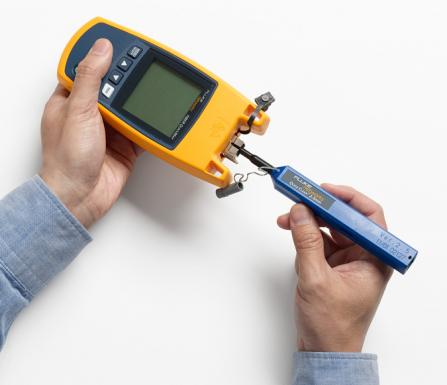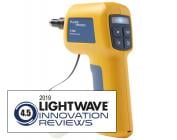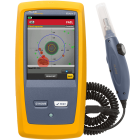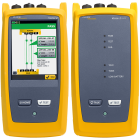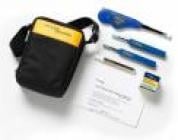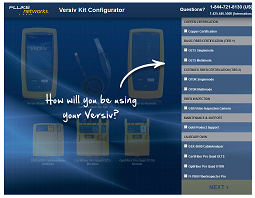New Solutions for VSFF Applications
August 12, 2025 / General, Best Practices
New very small form-factor (VSFF) connectors — MDC, CS, and SN duplex connectors and MMC multi-fiber connectors — are increasingly popular in high-density fiber applications like data centers. They must be properly tested, inspected, and cleaned to keep everything running smoothly. Whether you’re installing, reconfiguring, or troubleshooting, certain essential tools can make certifying link performance and inspecting for and eliminating contamination more efficient.
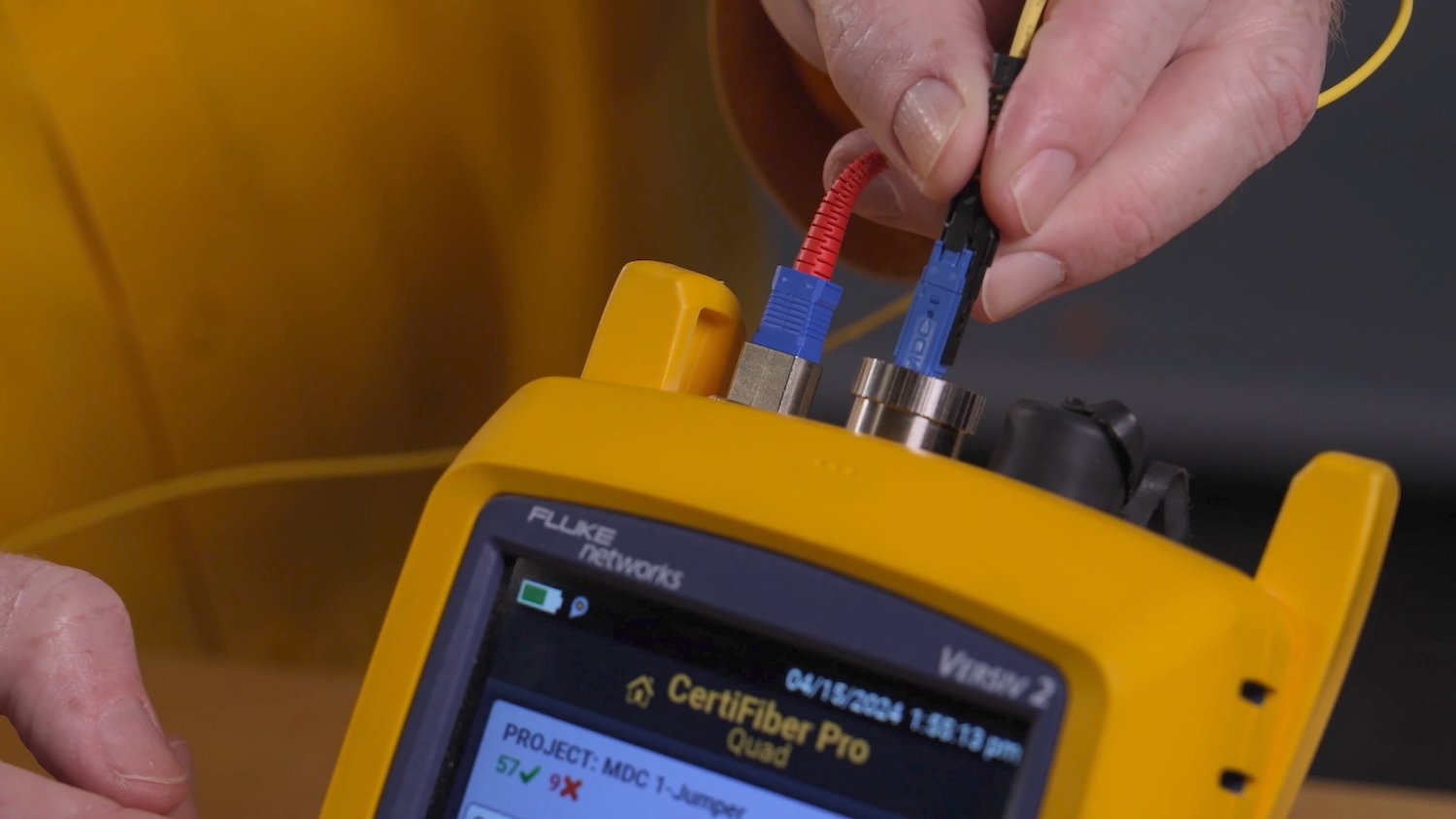
Certifying Link Performance Ensures Application Support
Industry standards publish maximum insertion loss values and link lengths for specific applications. Tier 1 certification that measures total insertion loss and link length is therefore essential to ensure application support. Certification testing also checks for continuity and polarity to ensure proper function.
Tier 1 certification is typically a prerequisite for acquiring a warranty on your fiber cabling system. It is also the best way to prove the quality of an installation, and it serves as a performance benchmark for any future troubleshooting.
To certify fiber links in the data center, you need an optical loss test set (OLTS) like the Fluke Networks CertiFiber™ Pro and Test Reference Cords (TRCs). The first step in certification testing is to account for the loss of the TRCs by setting a reference. This should be done using the recommended 1-jumper reference method, which includes the loss of connections at both ends and offers the least uncertainty. On the CertiFiber Pro, setting a 1-jumper reference is easy with the Set Reference Wizard, which steps you through the process of setting the reference and verifying the performance of the TRCs using intuitive animation.
To make a 1-jumper reference, your OLTS and TRCs must have the same connector interface as the link under test. If they don’t, you may need to use the less accurate 3-jumper reference with a hybrid TRC. Thankfully, the CertiFiber Pro is available with a variety of interchangeable adapters and TRCs to accommodate testing with a 1-jumper reference, including new MDC VSFF adapters and TRCs. Check out this video with our own Jim Davis to see how to test a fiber link terminated to an MDC VSFF connector using the 1-jumper reference with the CertiFiber Pro.
| How to test an MDC connector with Fluke Networks CertiFiber Pro |
Always Inspect Connectors for Contamination
Before mating any fiber connectors — whether on patch cords and trunks or on the TRCs used in certification testing — every fiber end face should be inspected to verify cleanliness. Contamination is the single greatest cause of fiber failures; a single particle on the core of a fiber can cause loss and reflections that degrade network performance. Contaminated end faces on patch cords can also damage fiber ports on expensive active equipment like switches and servers. While you should only clean fiber end faces if necessary (since the very act of cleaning can cause contamination), the only way to know if an end face is clean is to inspect it.
|
The only way to know if an end face is clean is to inspect it. The most reliable way to do that is to use a tool designed for the job. |
When it comes to inspecting fiber end faces, the IEC 61300-3-35 standard defines the criteria for minimum microscope compliance, inspection procedures, and grading cleanliness based on the quantity and size of defects and scratches in the core and cladding area of a fiber end face. Manually counting and measuring scratches and defects based on the IEC standard would be extremely time-consuming and prone to human error. It’s better to use an inspection solution like the Fluke Networks FI-3000 / F12-7300 FiberInspector™ Ultra or FI-7000 FiberInspector™ Pro — they employ an algorithmic process to grade and certify fiber end faces (based on the IEC 61300-3-35 criteria) and provide automatic PASS/FAIL results.
Inspecting individual fiber end faces for duplex MDC, SN, and CS VSFF connectors is easy with the FI-7000 FiberInspector Pro inspection scope, which certifies cleanliness to IEC61300-3-35. It highlights defects that fail in red and end faces that pass in green. The FI-7000 uses the Versiv™ modular design to work with the CertiFiber Pro OLTS for easy inspection during testing. The Set Reference Wizard on CertiFiber Pro even includes a Fiber Inspector button to remind and allow you to inspect TRC connectors while setting a reference.
Using interchangeable tips, the FI-3000 FiberInspector Ultra offers automated PASS/FAIL inspection of multi-fiber connectors to the IEC 61300-3-35 standard, including 12-, 16-, 24-, and 32-fiber MPOs and VSFF MMCs. It features autofocus and live view of an entire multi-fiber end face, with the ability to zoom in on a specific fiber for more detail. Because the FI-3000 features an ergonomic design, built-in PortBright™ illumination, and the ability to zoom in on single fiber end faces, it is ideal for inspecting both duplex and multi-fiber VSFF bulkhead connectors in high-density data center environments. The FI-3000 also integrates with the Versiv system to provide a single platform for Tier 1 testing, Tier 2 testing, and inspection.
Clean Only When Necessary
While you should only clean fiber end faces if inspection fails and the connector is contaminated, having the right cleaning tools at your fingertips saves time and materials. When cleaning end faces, you should only use solvents and wipes specially formulated for fiber. Canned air and dusters just blow particles around; they don’t effectively clean oil, residues, or small charged dust particles. Isopropyl alcohol or other solvents not designed for fiber can leave behind residue that can be difficult to remove. Fluke Networks fiber optic cleaning kits include a specially formulated solvent pen and cleaning cube with 125 lint-free wipes, each capable of cleaning up to four end faces.
|
A Fluke Networks Quick Clean cleaner is designed to reach into tight spaces like equipment ports to clean consistently without residue. |
When it comes to cleaning end faces inside patch panels or equipment ports, including the interface on your tester, easy-to-use Quick Clean™ cleaners are the go-to solution. Unlike traditional swab cleaners that rely on the user’s technique, Quick Clean cleaners use a simple pushing motion with an audible click that provides consistent cleaning every time. Quick Clean cleaners come in a wide range of connector types, including VSFF duplex MDC and multi-fiber MMC.
The Whole Kit and Caboodle
When it comes to testing, inspecting, and cleaning newer VSFF connectors in the data center, having the right tools isn’t just necessary — it’s a long-term investment that lets you maximize uptime and reliability while protecting your business and boosting your revenue.
|
The Fluke Networks Fiber Inspection Kits (with or without Wi-Fi) includes everything required for inspecting and cleaning VSFF (MDC duplex and MMC multi-fiber) and other connectors. |
To make that investment easier, Fluke Networks Data Center Kits save you time and money by putting everything you need right at your fingertips in a convenient, organized, and complete package that takes up less space and eliminates the task of searching for (and buying) individual tools.
Keep Learning
- • What You Should Know About VSFF Connectors
- • Easier Fiber End Face Inspections: Key Changes to IEC 61300-3-35
- • Top 10 Cable Testing Mistakes to Avoid
- • Fiber Optic Testers
- • OTDR - Optical Time Domain Reflectometer
- • Testing Optical Fiber Cabling Terminated with CS Connectors
- • 101 Series: Set Your Reference Like a Wizard!


